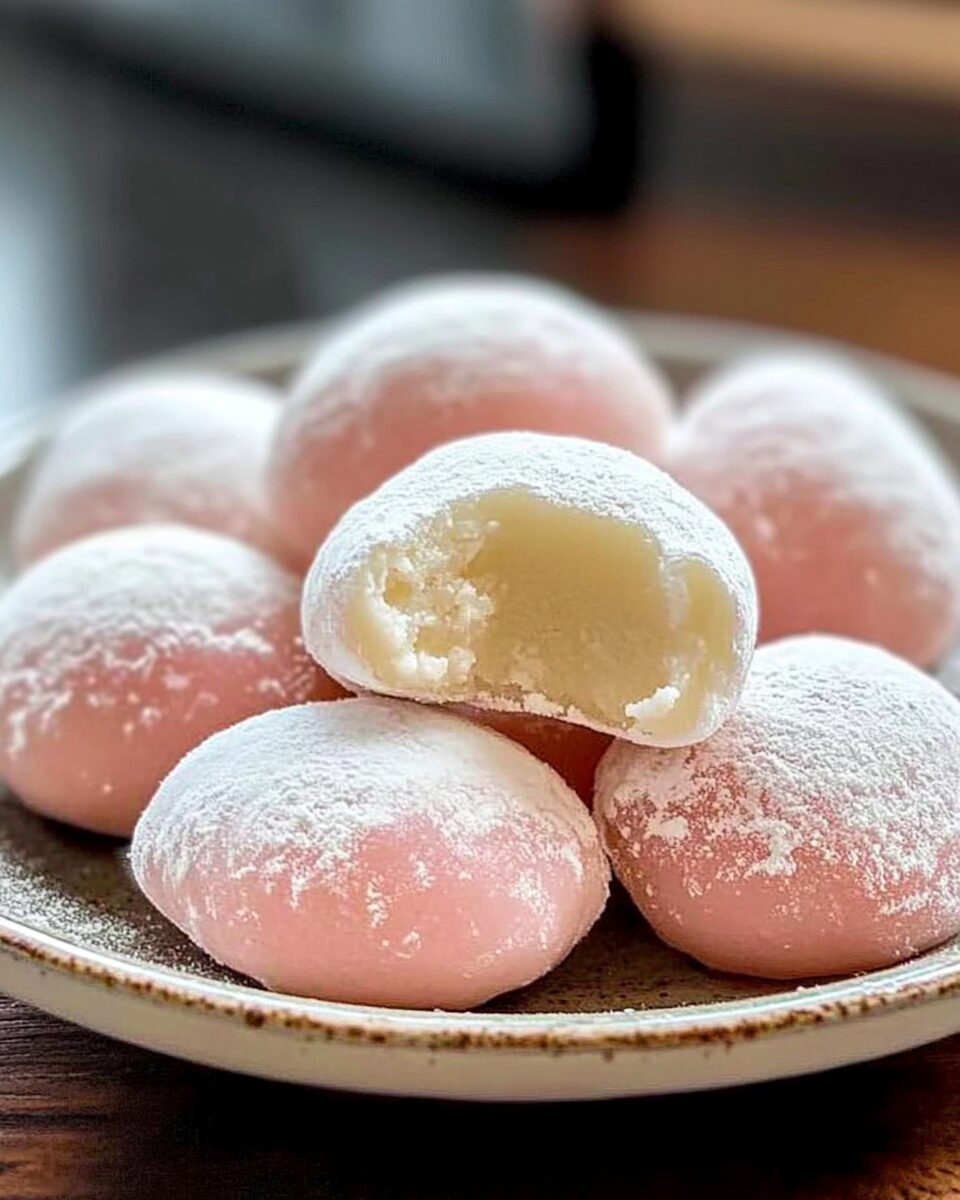These chewy Japanese mochi bites are soft, sweet, and delightfully sticky treats made from glutinous rice flour. Perfect as a dessert or snack, they offer a satisfyingly chewy texture and can be flavored or dusted in various ways. Easy to prepare with minimal ingredients, these mochi bites are a delightful introduction to traditional Japanese sweets.
FULL RECIPE
Ingredients
- 1 cup glutinous rice flour (mochiko)
- 3/4 cup water
- 1/4 cup granulated sugar
- 1/4 teaspoon vanilla extract (optional)
- Potato starch or cornstarch, for dusting
Directions
- In a microwave-safe bowl, mix glutinous rice flour, water, sugar, and vanilla extract until smooth.
- Cover loosely with plastic wrap or a microwave-safe lid.
- Microwave on high for 1 minute. Stir the mixture.
- Repeat microwaving in 1-minute intervals, stirring after each, for 2–3 more minutes until the dough becomes translucent and sticky.
- Generously dust a clean surface with potato starch or cornstarch.
- Transfer the hot mochi dough onto the surface and dust the top with more starch to prevent sticking.
- Allow the mochi to cool slightly until safe to handle.
- Using your hands or a knife, cut or pinch off small bite-sized pieces.
- Roll each piece into a ball or desired shape, dusting with additional starch as needed.
Nutritional Information
- Calories: 50
- Carbohydrates: 12g
- Sugar: 4g
- Fat: 0g
- Protein: 0.5g
- Fiber: 0g
- Sodium: 1mg
Cultural Significance of Mochi in Japan
Mochi holds deep cultural roots in Japan and is much more than a sweet treat. It is traditionally associated with good fortune and is commonly consumed during special occasions like Japanese New Year. Mochi is believed to offer spiritual protection and symbolize longevity and prosperity, making it a staple in Japanese rituals and festivals. Its preparation and consumption have long been linked to family unity and shared celebrations.
Texture and Flavor Profile
Chewy Japanese mochi bites offer a unique mouthfeel—soft, springy, and sticky with a subtle sweetness. The flavor is neutral enough to complement a variety of additions such as matcha, red bean paste, or fruit. What stands out most is the texture, which contrasts from typical Western desserts. It’s this chewiness that many find addictive and comforting.
Variations Across Regions
While mochi is popular across Japan, regional variations offer distinct interpretations. In Kyoto, mochi is often filled with sweetened red bean paste and served during tea ceremonies. In Hiroshima, grilled mochi topped with soy sauce or seaweed is common. These chewy bites, made in a simplified format, are a modern and accessible take on a centuries-old tradition.
Why Glutinous Rice Flour is Essential
Glutinous rice flour, also called mochiko, is what gives mochi its signature chew. Despite the name, it contains no gluten. It behaves differently than regular rice flour, absorbing more water and creating a stretchy, pliable dough once cooked. This flour cannot be substituted without altering the final texture dramatically.
Popular Occasions to Serve Mochi
Chewy mochi bites are perfect for family gatherings, holidays, tea parties, and cultural festivals. In modern times, they are also commonly served as a fun snack during movie nights or included in bento boxes. Their small, manageable size makes them ideal for serving at events or as part of a dessert platter.
Modern Adaptations
Contemporary versions of mochi bites include flavor infusions like matcha, cocoa, and fruit puree. Some people even stuff them with ice cream or chocolate. These adaptations make the treat more versatile and appealing to international audiences while retaining the core characteristics of traditional mochi.
Health Considerations
Mochi is naturally gluten-free and low in fat, which appeals to health-conscious eaters. However, due to its high starch content and chewiness, it should be eaten in moderation. Individuals with swallowing difficulties should consume it cautiously, as its sticky nature can pose a choking hazard if not chewed thoroughly.
Storage and Shelf Life
Chewy mochi bites are best enjoyed fresh, but they can be stored in an airtight container at room temperature for up to two days. For longer storage, freezing is recommended. When frozen, allow them to thaw at room temperature before serving. Reheating is not necessary but can revive some of the chewiness.
Common Mistakes to Avoid
One common mistake is using regular rice flour instead of glutinous rice flour, resulting in a completely different and non-chewy texture. Another error is overcooking or undercooking the dough, which affects both the consistency and flavor. Excess moisture or too little starch during shaping can also lead to sticking and messiness.
Pairing Suggestions
Mochi pairs well with green tea, especially matcha, which complements its subtle sweetness. It also goes well with coffee, light fruit teas, or even sparkling water with a hint of citrus. These chewy bites can be served alongside fresh fruit, ice cream, or whipped cream for a more elaborate dessert.
Tools You’ll Need
Basic kitchen tools like a microwave-safe bowl, spatula, plastic wrap, and a clean flat surface are all you need to make mochi bites. A dough cutter or knife can help portion the dough evenly. Having starch on hand is essential for dusting and managing stickiness.
Kid-Friendly Treat
These chewy treats are fun for kids to help make and eat. They enjoy rolling and shaping the dough, especially when mochi is colored or flavored. However, supervision is important during preparation and eating, due to the sticky nature of the mochi dough.
Vegan and Allergen-Friendly
The basic mochi recipe is vegan and free of dairy, eggs, and nuts, making it suitable for a wide range of dietary restrictions. However, if you plan to fill or flavor the mochi, it’s important to check the ingredients of any additions to maintain its allergen-free quality.
Presentation Ideas
For a visually appealing presentation, mochi bites can be dusted with matcha powder, cocoa powder, or freeze-dried fruit powder. Using food-safe colored starch or adding food coloring to the dough can make them more festive. Serving them in mini cupcake liners or skewered on decorative toothpicks elevates their appearance.
Incorporating into Bento Boxes
Mini mochi bites make excellent additions to Japanese-style bento boxes. Their compact size and low mess factor make them ideal as a sweet ending to a savory meal. A small piece adds both color and texture contrast to the bento ensemble.
How to Flavor Your Mochi
Flavors can be added to the base dough through extracts like vanilla, almond, or citrus. Natural powders like matcha, cocoa, or freeze-dried fruit can be mixed in for both color and flavor. Additionally, fillings such as sweetened bean paste, jam, or chocolate chips can be added for a surprise inside.
Texture Comparison with Other Treats
Compared to Western desserts like cake or cookies, mochi is significantly chewier and denser. It’s closer in texture to Turkish delight or gummy candy, but softer and more elastic. This makes it stand out and often intrigues those unfamiliar with Japanese confections.
History of Mochi-Making
Mochi-making dates back over a thousand years and was originally a ceremonial activity. Traditionally made by pounding cooked glutinous rice in large mortars, it required strength and teamwork. Though this labor-intensive method is still used during cultural festivals, modern versions simplify the process for everyday cooking.
Inspiration for Dessert Tables
Chewy mochi bites bring variety to dessert tables and are a conversation starter thanks to their unique look and feel. You can include them alongside other bite-sized treats such as macarons, truffles, or mini cupcakes. Their simple design and pastel colors help balance visually busier dessert spreads.
Conclusion
Chewy Japanese mochi bites are more than just a sweet indulgence—they’re a cultural symbol, a culinary experience, and a textural adventure all in one. Their simplicity, adaptability, and satisfying chewiness make them a standout treat for both traditionalists and modern food lovers alike. Whether you’re sharing them at a family celebration or savoring them alone with a cup of tea, mochi bites provide a meaningful, delicious connection to Japanese culture that resonates with every soft, stretchy bite.






